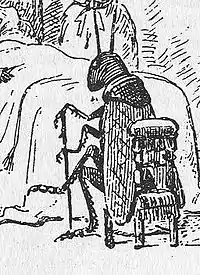Talking Cricket
The Talking Cricket (Italian: Il Grillo Parlante) is a fictional character that appears in the 1883 Italian book The Adventures of Pinocchio (Le avventure di Pinocchio) by Carlo Collodi.[1][2][3]
| Talking Cricket | |
|---|---|
| The Adventures of Pinocchio character | |
 Il Grillo Parlante, as illustrated by Enrico Mazzanti | |
| First appearance | The Adventures of Pinocchio |
| Created by | Carlo Collodi |
| In-universe information | |
| Species | Cricket |
| Gender | Male |
| Nationality | Italian |
Role

The Talking Cricket, which has lived in Geppetto's house for over a century, makes his first appearance in chapter IV, after Pinocchio's mischief has landed his creator Geppetto in prison, and insists that Pinocchio must either attend school or work, to function properly in the world. When Pinocchio refuses to listen, the Cricket states, "You are a puppet and what's worse is that you have a head of wood", whereupon Pinocchio throws a mallet at the cricket, killing him.
In chapter XIII, the Talking Cricket appears as a ghost to Pinocchio, telling him to return home rather than keep an appointment with the Fox and the Cat (Il Gatto e la Volpe). Pinocchio refuses and in chapter XIV, he is subsequently injured.
The Talking Cricket reappears in chapter XVI, where he and his colleagues, the Crow and the Owl, tend to Pinocchio's injuries.
The Talking Cricket makes his final appearance in chapter XXXVI, living in a house given to him by the Fairy with Turquoise Hair, where he allows Pinocchio and the ailing Geppetto to stay while Geppetto recovers his health.
Media portrayals

- In the 1940 Disney film Pinocchio, the Talking Cricket is renamed Jiminy Cricket (voiced by Cliff Edwards) and portrayed very differently, as he becomes Pinocchio's inseparable companion and advisor, under instructions from the Fairy with the Turquoise Hair (renamed the 'Blue Fairy').[4][5] His relationship with Pinocchio is much less adversarial than in the book as he accompanies Pinocchio on his adventures. Jiminy Cricket also appeared as the host of the two story segments in the theatrical release Fun and Fancy Free, as well as in several recurring segments of the children's television series The Mickey Mouse Club, and he later appeared as the Ghost of Christmas Past in Mickey's Christmas Carol. Jiminy also appeared as a Disney mascot. Jiminy Cricket later appears in Disney's House of Mouse and Kingdom Hearts voiced by Eddie Carroll. In later projects following Eddie Carroll's death, Phil Snyder and Joe Ochman have since voiced Jiminy Cricket.

- In Giuliano Cenci's 1972 animated film The Adventures of Pinocchio, the Talking Cricket (voiced by Lauro Gazzolo), though anthropomorphized, differs little from the character of the novel, but gets killed after Pinocchio throws a mallet at the cricket like in the original novel. The only difference in characterization is that he does not reappear in the Fairy's house as a doctor.
- In Steve Barron's 1996 live action film The Adventures of Pinocchio, the Talking Cricket is a CGI character named Pépé (voiced by David Doyle, in his final film performance one year before his death in 1997) and is also portrayed similar to Jiminy Cricket. He is an optimistic character who advises Pinocchio against Volpe and Felinet as well as the main antagonist Lorenzini and also accompanies Pinocchio on his adventures. He was supposed to be voiced by Wallace Shawn but was likely re-casted at the last minute, though Shawn's voice can be heard in one of the trailers. He would reappear in the film's 1999 sequel The New Adventures of Pinocchio, this time voiced by Warwick Davis.
- In the Happily Ever After: Fairy Tales for Every Child episode "Pinocchio", the Talking Cricket is actually a termite named Woody (voiced by Chris Rock), but is portrayed very much like Jiminy Cricket.
- In Roberto Benigni's 2002 live action film Pinocchio, the Talking Cricket also made an appearance and is played by Peppe Barra with John Cleese doing his English voice-dub. The Cricket is similar to Jiminy Cricket and (like him) is a companion to Pinocchio.
- The Talking Cricket (under his Disney alias) appears in Once Upon a Time, played by Raphael Sbarge. His human alter-ego is local psychiatric counselor, and part-time legal advisor, 'Dr. Archie Hopper', in which he is much more timid than in his Cricket guise.
- The Talking Cricket appears in the 2008 Italian-British miniseries Pinocchio, portrayed as female by Luciana Littizzetto.
- The Talking Cricket appeared in the 2012 Pinocchio film, voiced by Carlo Valli with his English dub voice provided by Arthur Grosser.
- In the live-action Italian film Pinocchio (2019), co-written, directed and co-produced by Matteo Garrone, the Talking Cricket is portrayed by midget actor Davide Marotta, while his English dub voice is provided by Luca Dal Fabbro.
- In the 2021 stop motion Netflix film Pinocchio that was produced, written and directed by Guillermo del Toro, The Talking Cricket was voiced by Ewan McGregor.
References
- Joy Lo Dico. "Classics corner: Pinocchio by Carlo Collodi | Culture". The Guardian. Retrieved 2015-07-01.
- Wunderlich, Richard; Morrissey, Thomas J. (2014-04-04). Pinocchio Goes Postmodern: Perils of a Puppet in the United States - Richard Wunderlich, Thomas J. Morrissey. ISBN 9781135023171. Retrieved 2015-07-01.
- "Pinocchio's Real Roots Mapped". News.discovery.com. 2011-07-08. Retrieved 2015-07-01.
- Zipes, Jack (2013-08-21). Happily Ever After: Fairy Tales, Children, and the Culture Industry - Jack Zipes. ISBN 9781135252960. Retrieved 2015-07-01.
- Rich, Nathaniel (2011-10-24). "Carlo Collodi's Pinocchio: Why is the original Pinocchio subjected to such sadistic treatment?". Slate.com. Retrieved 2015-07-01.
Bibliography
- Collodi, Le Avventure di Pinocchio 1883, Biblioteca Universale Rizzoli